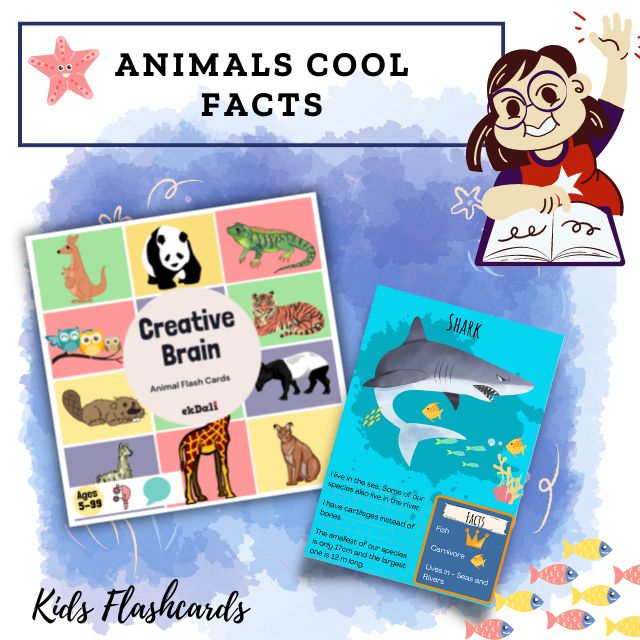The above flashcards are part of the Creative Brain Animals of the World Flashcard series
SHARK FACTS FOR KIDS
- Sharks have cartilaginous skeletons that are much lighter than true bone and their large livers are full of low-density oils, both helping them to be buoyant.
- As sharks age, they deposit calcium salts in their skeletal cartilage to strengthen it. The dried jaws of a shark appear and feel heavy and solid much like bone.
- The back of sharks’ eyeballs have a reflective layer of tissue called a tapetum. This helps sharks see extremely well with little light. Sharks can see well in dark-lighted areas, have fantastic night vision, and can see colors.
- Sharks have small black spots near the nose, eyes, and mouth. These spots are special electroreceptor organs that allow the shark to sense electromagnetic fields and temperature shifts in the ocean.
- Shark skin feels exactly like sandpaper because it is made up of tiny teeth-like structures called placoid scales, also known as dermal denticles. These scales point toward the tail and help reduce friction from the surrounding water when the shark swims.
- Based on fossil scales found in Australia and the United States, scientists hypothesize sharks first appeared in the ocean around 455 million years ago.
- Whale sharks are the biggest fish in the ocean. They can grow up to 18 meters approx. and weigh as much as 19,000 kg by some estimates.
- The whale shark is a slow-moving, filter-feeding carpet shark and the largest known extant fish species. The largest confirmed individual had a length of 18.8 m. The whale shark holds many records for size in the animal kingdom, most notably being by far the largest living nonmammalian vertebrate.
- Sharks live in the ocean, from shallow waters to the deepest parts of the ocean. They can be found in all major oceans like the Pacific Ocean, Atlantic Ocean, Artic Ocean, and Indian Ocean. Well, some sharks even live in rivers, like the River Shark, Bull Shark, and Spear Tooth Shark.
- Sharks communicate with each other using body language, such as lowering their fins, arching their backs, opening their jaws, and nodding their heads, which can be social signals as two sharks 'talk' to each other. For example, when two sharks are after the same prey, they will put on a slapping display to deter the other.
- Sharks never run out of teeth. They can grow up to 5 to 15 rows of teeth arranged in layers. They can grow up to 20,000 teeth in their lifetime. Mako Sharks and White sharks leave a tell-tale mark on their prey. A Sandbar Shark will have up to 35000 teeth in their lifetime.
- The age of other shark species can be estimated by counting growth bands on fin spines or on the shark's vertebrae, much like rings on a tree.
- Blue Shark, Tiger Shark, Nurse Shark, Great White Shark, Bull Shark, Black Tip Shark, Oceanic White Tip Shark, and Short Fin Mako Shark are some of the most dangerous species of shark.
- Sharks eat plankton, shellfish, sea turtles, fishes, seals, porpoises, squid, or whales, a wide variety of animals, marine mammals, mollusks, and much more.
- There are oviparous (egg-laying) species and viviparous (live-bearing) species. Oviparous species lay eggs that develop and hatch outside the mother's body with no parental care after the eggs are laid. When a baby shark is born, they have teeth and defend itself.
|
FOOD |
FISHES. MAMMALS, SEALS, SQUIDS |
|
GENDER NAMES |
MASCULINE-SHARK, FEMININE-SHARK |
|
YOUNG ONES |
PUPS |
|
COLOUR |
BROWN, BLUE, GREY, BLACK, WHITE |
|
SIZE |
LENGTH:10-18 MTRS WEIGHT: 600KG TO 20,000KG |
|
LIVES IN |
OCEANS, RIVERS |
HERE IS A FUN QUIZ ABOUT SHARKS THAT YOU CAN ATTEMPT. THIS IS BASED ON WHAT YOU HAVE READ SO FAR.
- What are the young ones of a shark called?
- Which is the biggest shark in the world?
- Do sharks have good vision?
- How do sharks communicate with each other?
- How is the age of sharks calculated?
- What is the tissue behind the eyeball of a shark called?
- Name some sharks that live in the rivers
- What type of skeleton system does a shark have?
ANSWERS TO THE QUIZ
- Pups
- Whale sharks are the biggest in the world.
- Yes, they can see extremely well with little light.
- They communicate by lowering their fins, arching their backs, opening their jaws, and nodding their heads.
- By counting growth bands on fin spines or on the shark's vertebrae, much like rings on a tree.
- Tapetum is the tissue behind the eyeball.
- River Shark, Bull Shark, and Spear Tooth Shark.
- Sharks have cartilaginous skeletons that are much lighter than true bone.
Why Flashcards:
Flashcards are a great learning and fun mechanism. Here are some advantages of Flashcards
1. Flashcards contain small bits of information, so it is easy to learn and memorize
2. Flashcards are a conveninet size to carry around
3. Flashcards can be used to play quiz games
4. Flashcards have colourful pictures making learning fun
Check out our Creative Brain Flashcard Series- We have covered 3 topics.
ABOUT THE AUTHOR:
Saffura is a mother of three. She is a yoga instructor and has spent a lot of time teaching yoga for children. She narrates numerous stories to inculcate moral values in children, as she is certain that yoga is for the body and soul. As a mother and yoga instructor, She enjoys new tasks and likes multitasking. She truly believes that will mould her into a strong writer. As a writer she does a lot of research and pays keen attention to details.
























